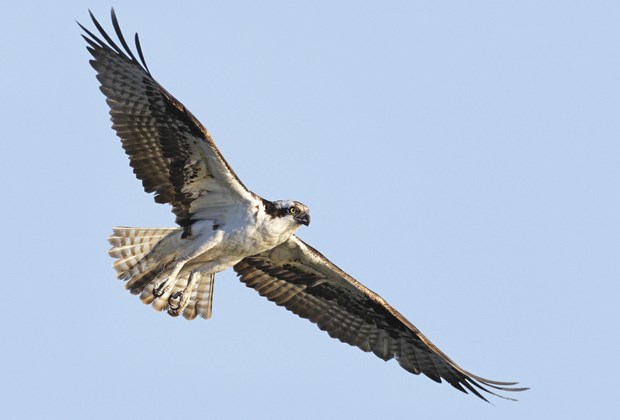August brings many changes in nature's calendar; some are obvious, while others are more subtle.
Mid-summer is a busy time for our birds with much time spent raising their families.
Osprey young at the Conservation Area at Maplewood Flats wait patiently for parents to bring them food and in the case of ospreys it is fish. In fact, in days of yore the osprey was known as the fish hawk. It's amazing to watch as it hovers above the water and suddenly plunges downward with a dramatic splash, usually coming up with a fish. However the fish is caught, the osprey needs to fly with its prey headfirst - tail first won't work. In five to six weeks or so our ospreys will leave for warmer places down south, maybe Baja, or a sleepy river in Central America. Our hearts go with them for a safe return next year.
Martins and their cousins the swallows can be seen swooping gracefully through the air scooping up insects. In the martin's case, it may be a dragonfly, especially the big blue types called darners.
A fine place at the conservation area to observe both ospreys and martins is Osprey Point next to the butterfly garden. It is also a great spot to watch for river otters (also known as the Canada otter). I recently watched a mother otter teaching her family how to catch fish or crabs.
August is the month to watch for waders, also called shorebirds, which includes sandpipers and plovers. Southwestern B.C. is a world-class migration corridor for many species of shorebirds on their way from breeding grounds in the far north to wintering habitats in South America. Species to be watched for include western sandpiper, least sandpiper, greater and lesser yellowlegs, semipalmated plover and pectoral sandpiper. And there is always the possibility of discovering a rarity like longbilled curlew.
The following are a couple of hints about shorebird watching: Watch the tides - not too high, not too low! Also, binoculars are fine for most birding situations, but a good spotting scope really makes a difference. Seek advice from your local wild bird store regarding optics like scopes.
I might add a third bit of advice: Get a good field guide that covers shorebirds well (app or paper). It needs to be complete.
Maplewood Flats plays an important role for shorebirds and other local wildlife. It is a critical habitat where these birds can feed and rest on their long migrations. Shorebirds like western sandpiper feed on invertebrates, worms, and "a soup" or biofilm that coats the mudflats, consisting of microorganisms like diatoms.
Following shorebirds on their migration are raptors, like the merlin and peregrine. Watch for them chasing waders or resting atop a dolphin or piling.
Waterfowl that breed in northern areas begin moving south in August, for example, white-winged scoters were reported in Burrard Inlet recently.
Ring-billed gulls are showing up locally and there's always a good chance of spotting Caspian terns off shore. You can often hear the terns before you see them because of their raucous calls.
Song birds are a little harder to find in late summer - let's say it's a little more challenging because they're not singing the way they were in spring (remember the dawn chorus?) The red-eyed vireo is one exception and proclaims itself with song well into summer. Again, in days of yore, the redeyed vireo was called the "preacher bird." It's said to sing something like 20,000 times a day!
Walking Maplewood's trails you can listen for various squeaky notes from begging young. If you see a bird and you think it's recently fledged, look at its bill (from a distance) for a coloured edge called the gape mark. It's probably not abandoned and its parents are somewhere close searching for food for the youngster.
Keep your eyes always glancing skyward, not only for martins and swallows, but also for swifts (two species, nighthawks and vultures). It is interesting to note that a nighthawk is not a hawk at all, but a member of the goatsucker family.
By the end of August most of Rufous hummingbirds will have left us (according to the Vancouver Area checklist - Nature Vancouver, 2013). The Rufous hummingbirds make an incredible journey all the way to Mexico. Anna's is the other regularly seen hummingbird on the North Shore year-round.
August is also an excellent month to watch for butterflies and dragonflies at the conservation area. A wonderful guide to local butterflies, featuring colour photos, is available at the sanctuary office for $4. Author Dick Beard also includes information about larval (caterpillars) food plants and nectar sources - all valuable information in
helping to turn your garden into a butterfly sanctuary.
Berries are ripe, birds are on the move and there is an abundance of colourful wildflowers - it's August at the conservation area and a delightful time to be outdoors.
Al Grass is a naturalist with Wild Bird Trust of B.C., which offers free walks at the Conservation Area at Maplewood Flats on the second Saturday of every month. The next walk will be Saturday, Aug. 9 starting at 10 a.m. where those in attendance will search and listen for the sights and sounds of fall approaching at the conservation area. Meet at WBT's site office, 2645 Dollarton Hwy. Walks go rain or shine.



